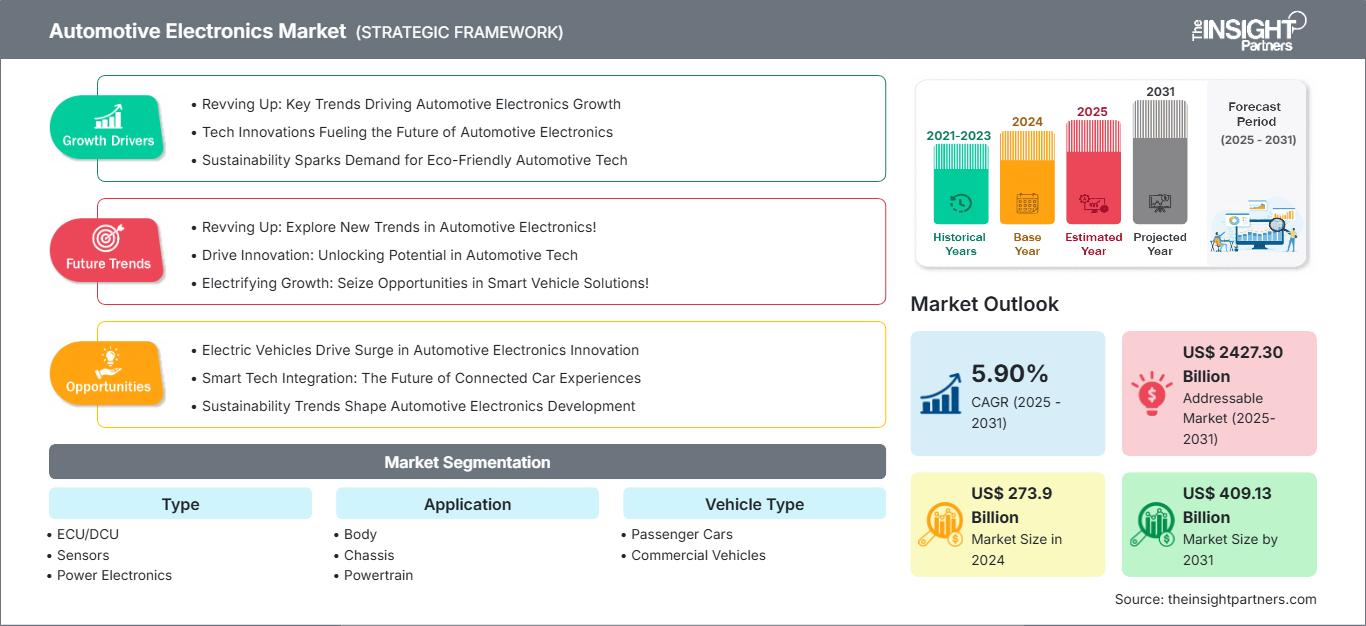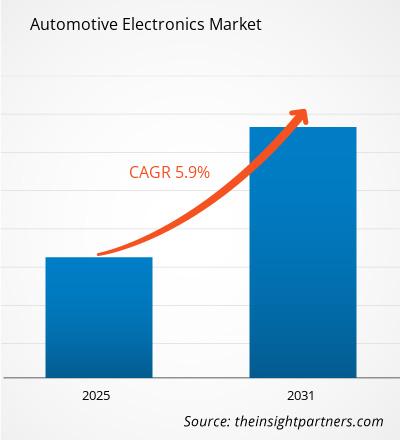预计到2031年,汽车电子市场规模将达到4540.5亿美元。预计2025年至2031年期间,该市场将以8.5%的复合年增长率增长。
本报告按类型(ECU/DCU、传感器、电力电子)进行分类,并进一步基于应用(车身、底盘、动力总成、信息娱乐系统、ADAS/AD)分析市场。此外,报告还按车辆类型(乘用车、商用车)对市场进行分析。报告对每个关键细分市场均提供了全球、区域和国家层面的全面细分数据。
报告包含所有细分市场的市场规模和预测,并以美元计价。报告还提供了主要参与者当前市场地位的关键统计数据,以及对当前市场趋势和新兴机遇的深入见解。
报告目的
The Insight Partners发布的《汽车电子市场报告》旨在描述当前市场格局和未来增长趋势,重点分析主要驱动因素、挑战和机遇。该报告将为各类商业利益相关者提供参考,例如:
- 技术提供商/制造商:了解不断变化的市场动态和潜在的增长机会,从而能够做出明智的战略决策。
- 投资者:对市场增长率、市场财务预测以及整个价值链中存在的机会进行全面的趋势分析。
- 监管机构:监管市场政策和执法活动,旨在最大限度地减少滥用行为,维护投资者信任和信心,维护市场的诚信和稳定。
汽车电子市场细分类型
- ECU/DCU
- 传感器
- 电力电子
应用
- 身体
- 机壳
- 动力系统
- 信息娱乐
- ADAS/AD
车辆类型
- 乘用车
- 商用车辆
您可以免费获得任何报告的定制服务,包括本报告的部分内容、国家/地区层面的分析、Excel 数据包,以及面向初创企业和高校的优惠折扣。
汽车电子市场:战略洞察

-
获取本报告的主要市场趋势。这份免费样品将包含数据分析,内容涵盖市场趋势、估算和预测等。
汽车电子市场增长驱动因素
- 汽车电子行业增长加速:关键趋势
- 技术创新推动汽车电子行业的未来发展
- 可持续发展激发了对环保型汽车技术的需求
汽车电子市场未来趋势
- 加速前进:探索汽车电子领域的新趋势!
- 驱动创新:释放汽车技术的潜力
- 电气化增长:把握智能汽车解决方案带来的机遇!
汽车电子市场机遇
- 电动汽车推动汽车电子创新激增
- 智能技术融合:互联汽车体验的未来
- 可持续发展趋势塑造汽车电子产品发展
汽车电子市场区域洞察
The Insight Partners 的分析师对预测期内影响汽车电子市场的区域趋势和因素进行了详尽的阐述。本节还探讨了北美、欧洲、亚太、中东和非洲以及南美和中美洲等地区的汽车电子市场细分和地域分布。
汽车电子市场报告范围
| 报告属性 | 细节 |
|---|---|
| 2024年市场规模 | XX亿美元 |
| 到2031年市场规模 | 4540.5亿美元 |
| 全球复合年增长率(2025-2031年) | 8.5% |
| 史料 | 2021-2023 |
| 预测期 | 2025-2031 |
| 涵盖部分 |
按类型
|
| 覆盖地区和国家 |
北美
|
| 市场领导者和主要公司简介 |
|
汽车电子市场参与者密度:了解其对业务动态的影响
汽车电子市场正快速增长,这主要得益于终端用户需求的不断增长,而终端用户需求的增长又源于消费者偏好的转变、技术的进步以及消费者对产品优势认知的提高。随着需求的增长,企业不断拓展产品和服务,持续创新以满足消费者需求,并把握新兴趋势,这些都进一步推动了市场增长。

- 获取汽车电子市场主要参与者概览
主要卖点
- 全面覆盖:该报告全面分析了汽车电子市场的产品、服务、类型和最终用户,提供了全面的市场概况。
- 专家分析:该报告是根据行业专家和分析师的深入理解编制的。
- 最新信息:该报告涵盖了最新的信息和数据趋势,确保了其与业务的相关性。
- 定制选项:本报告可根据客户的具体需求进行定制,并能恰当地适应业务战略。
因此,这份汽车电子市场研究报告有助于深入了解和解读行业现状及增长前景。尽管其中可能存在一些合理的担忧,但总体而言,该报告的优势远大于劣势。
- 历史分析(2 年)、基准年、预测(7 年)及复合年增长率
- PEST和SWOT分析
- 市场规模、价值/数量 - 全球、区域、国家
- 行业和竞争格局
- Excel 数据集
近期报告
客户评价
购买理由
- 明智的决策
- 了解市场动态
- 竞争分析
- 客户洞察
- 市场预测
- 风险规避
- 战略规划
- 投资论证
- 识别新兴市场
- 优化营销策略
- 提升运营效率
- 顺应监管趋势






















 获取免费样品 - 汽车电子市场
获取免费样品 - 汽车电子市场